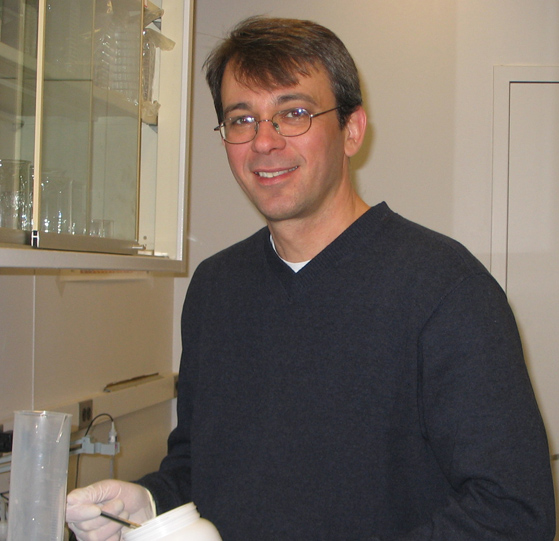


Rod Weilbaecher received his Ph.D. degree from the University of California at Berkeley and his A.B. degree from Washington University in St. Louis. He joined SIUC in December 2007 following postdoctoral training at the University of Texas - M.D. Anderson Cancer Center and Baylor College of Medicine.
(618) 453-1334
email: rweilbaecher@siumed.edu
Telomeres, the natural ends of chromosomes, provide intriguing solutions to the inherent problems associated with the replication and the protection of linear eukaryotic chromosomes. The telomeres of most eukaryotes are comprised of a repetitive sequence element, termed the telomere repeat. Telomere repeats direct the recruitment of proteins that protect chromosome ends from nucleolytic degradation and inappropriate fusion with other DNA ends. Conventional DNA replication is unable to fully replicate the terminal sequences at telomeres. Rather, a cellular reverse transcriptase, telomerase, preferentially extends short telomeres. In the absence of telomerase, multiple telomere repeats will be lost from the chromosome end following each cell division. Extremely short telomeres can trigger DNA damage checkpoints and cellular senescence.
Telomere length homeostasis is regulated and limits the proliferative potential of the cell. In the germ line, telomerase levels are sufficient to maintain telomeres, preventing telomere erosion. By contrast, during embryonic development telomerase expression is substantially attenuated in most somatic cells and adult stem cells. Developmental down-regulation of telomerase expression likely functions in tumor suppression, since >85% of human cancers re-activate telomerase expression. A detailed molecular understanding of the mechanisms that regulate telomerase activity may provide tractable targets for therapeutic intervention.
We focus on two aspects of telomeres. First, we want to understand the functions
of telomere binding proteins, particularly in regard to roles in regulating
telomerase access to its substrate. Second, we want to understand how certain
chromatin modifying complexes, such as the Set1 methyltransferase, facilitate
repression of RNA polymerase II transcription in telomeric heterochromatin as
well as influence telomere length homeostasis.
Van Dyke, M.W., Nelson, L.D., Weilbaecher, R.G., and D. V. Mehta. 2004. J. Biol. Chem., 279:24323 – 24333. Stm1p, a G4 quadruplex and purine motif triplex nucleic-acid binding protein, interacts with ribosomes and subtelomeric Y’ DNA in Saccharomyces cerevisiae.
Hughes, T.R., Evans, S.K., Weilbaecher, R.G., and V. Lundblad. 2000. Curr. Biol., 10:809 – 812. The Est3 protein is a subunit of yeast telomerase.
Hughes, T.R., Weilbaecher, R.G., Walterscheid, M., and V. Lundblad. 2000. Proc. Natl. Acad. Sci. U.S.A., 97:6457 – 6462. Identification of the single-strand telomeric DNA binding domain of Saccharomyces cerevisiae Cdc13 protein.
Weilbaecher, R.G. and V. Lundblad. 1999. Curr. Opin. Chem. Biol., 3:573 – 577. Assembly and regulation of telomerase.
![]() Biochemistry and Molecular
Biology Home Page
Biochemistry and Molecular
Biology Home Page